encounterBLOG 17 November, second night
„The robot often cries. Why shouldn’t you?“
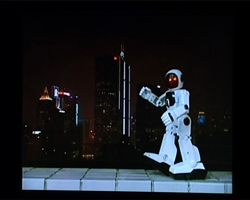 22:o1
22:o1
the second night features a networked performance by two artists, currently in Hong Kong (China), who were invited to experiment with the concept of the “tele-plateaus” in their own unique manner.
Ballettikka Internettikka Stattikka (enacted by Igor Stromajer and Brane Zorman)
the audience take their seats just before 22:oo CET (05:00 Hong Kong Time) inside the great hall, projections on the floor and an all side walls show the clock time in central European and Chinese time zones. we wait for time to reach the point of action at which transmission begins.
transmission here equals presence of the action elsewhere, beamed to Dresden from across the vast Asian continent. at 22:oo, the Skype phone rings from Hong Kong. after a few seconds, an image builds up, the action has already started. we see the tiny figure of a robot, frozen in a dance step on top of the roof railings high in the sky over Hong Kong. the little robot’s electric eyes blink. behind it, there are millions of tiny lights, and some of the facades of sky scrapers blink, too. music has begun to be heard, an ebb and flow of layers, sometimes dense and noisy, sometimes clear and hauntingly distinct, a singer from a Peking Opera, the happy chattering voice of a radio announcer from a Hong Kong radio station, advertisements, a Viennese waltz, dark rumbling electronic noises mixed with ambient static, motor sounds, city sounds, atmospheric sounds.
at exactly 22:30, the performance ends as the image from the rooftop slowly slowly fades away into black.
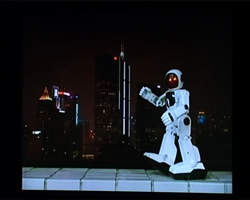 22:09
22:09
for 30 minutes we sat there, in Hellerau, listening and watching a transmission which can perhaps be described in several ways, and none are satisfactory. i say this as I recall noticing a certain frustration amongst the audience, a quiet, passive resignation, or perhaps quiet concentration, enjoyment? consternation? enchantment? i’m not sure. somehow this event challenged almost all available “theatrical” conventions: nothing happened, nothing moved. We listened to a still image.
but this is not true, of course. the live transmission was alive, there was constant motion, the sound and music, the voices, the flickering lights of the city, the steady rhythmic blinking of the little robot’s electrical eyes – a kind of electric heart-beat and a comic allusion to „liveness“ in the sense of this machinic/machinimatic doll’s being or realness which, magnified into a huge projection hovering on the Dresden Festspielhaus-floor, more and more looked like Armstrong or Gagarin stepping onto the Moon and (frozen moment of transmission from the planet) being momentarily arrested. a suspended stepping, over the edge.
 22:14
22:14
over the duration of 30 minutes, we heard a full symphony of sounds, an overture to the dawn in Hong Kong, an odyssee-mix of multiple musical and sonic worlds. a fantasia.
in other words, there was no still, no „static“ image. there was a „time image,“ and there was a live concert transmitted across the network, a performance of light and sound rhythms combined with a conceptual provocation which, for me, had deeper emotional resonances since I felt compelled to think of the sad little robot-figure on top of a cold skyscraper. it identified a postromantic scenario (beyond Caspar David Friedrich) if there ever was one, cruel and paradoxical, sad and fantastical.
 22:23
22:23
the artists deployed a (suicidal, autistic?) figure on the rooftop: a lonely commercial Silverlit R/C Robot Program-a-BOT. they exposed it to the elements up there, high in the sky. and the performance accomplished exactly what the artists had planned: the lonely robot „danced“ an almost static but still transitive Net Ballet for 30 minutes in an apparently stagnant Hong Kong dawn.
The networked event, even if the audience did not know the prior history of Stromajer’s internet ballets, should be considered quite centrally connected to the discourse of digital art, networked media art, hacktivism, loactive media and critical spatial practices. it is also an event within the history of situationism and site-specific art. in the context of networked „action“ – Ballettikka Internettikka Stattikka is an exemplary conceptual project – in RL and in telepresence, throwing a remarkable light on the Second Life performance improvisation we saw later this evening, created by Michael Takeo Magruder, with Ghislaine Boddington and a team of performers from Tokyo, Japan (including Yukihiko Yoshida, Gekitora, Kabayan, and Ruby Rumiko).
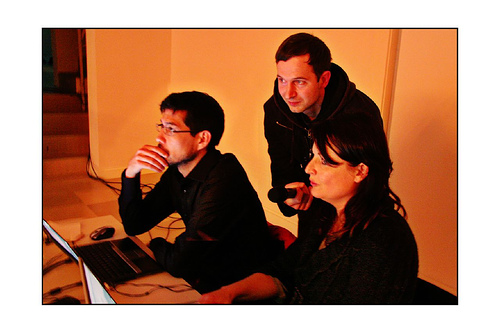
in the terms of the network artists, the project “Ballettikka Internettikka” is a tactical media arts project, involving guerilla or clandestine operations and a conceptual framework that is repeated each time one of the actions is performed. Ballettikka Internettikka is a series of spatial interventions which began in 2001 with the exploration of “internet ballet” – i.e. a form of “ballet” that could only be created in this particular network medium. its “aesthetic” is the exploration of wireless internet performance combined with guerrilla tactics and mobile live internet broadcasting strategies.
if you look at the history of the series, you find out that Stromajer and Zorman invaded, for example, The Bolshoi Theatre in Moscow (2002), La Scala in Milan (2004), The National Theatre in Belgrade (October 2005), VolksbĂĽhne in Berlin (2006). They entered secretly, found a room or hidden corner in these institutions, unpacked their laptops, webcams or dv cameras, and WiFi gear, and started to stream their clandestine performances to audiences on the internet.
In the context of Cynetart07, Stromajer and Zorman create an intervention in Hong Kong precisely timed to be received via the Internet in the Hellerau hall: Ballettikka Internettikka Stattikka thus becoming an element or practical exploration (or critical commentary) alongside the utopic idea of the tele-plateaus_01.
 22:28
22:28
Stromajer and Zorman had planned their intervention with great logistical precision (to demonstrate, I quote from the Cynetart catalog):
Action Timetable / Hong Kong, 17 November 2007 / GMT+1 (Dresden Local Time):
21:05 Final equipment check before entering the elevator of the Lippo Centre 2 building
21:15 Turning on the computers, cameras and other equipment
21:30 Taking the elevator up to the 48th floor
21:40 Exiting the elevator and climbing the set of stairs to the roof
21:50 Establishing wireless internet connection (wLAN) and positioning the robot and two cameras
21:59 Starting live internet broadcast and the almost static but still transitive internet ballet
– – – – – – – – – – – – – – – – – – – – – – – – – – – – – – – [ art ] – – – – – – – – – – – – – – – – – – – – – – – – – – – – – – –
22:30 Terminating almost static but still transitive internet ballet and live internet broadcast
22:32 Terminating wireless internet connection (wLAN) and securing the robot and two cameras
22:40 Descending the stairs and entering the elevator on the 48th floor
22:41 Taking the elevator down to the 1st floor (lobby)
22:51 Exiting the elevator and the Lippo Centre 2 building
23:00 Securing the material and turning off the computers, cameras and other equipment
TAD (Total Action Duration): 1 hour and 55 minutes
LBPD (Live Broadcast Performance Duration): 30 minutes
MTT (Maximum Time Tolerance): +/- 5 minutes
RREL (Real Risk Estimation Level): maximal
———- art ————
Question marks were raised by the local audience. to the word or the idea that sits here in between the dotted lines. someone argued that it is easy today to point a webcam at a city skyline, at any city, Bagdad, Jerusalem, Paris, New York, Hong Kong. but what is gained from such pointing. would the sad robot make a difference?
and how do we know, how the robot got there, the audience member seemed to say. why would it matter?
in the exhibition catalogue, the artists add that “dancing a wireless internet ballet on the roof of the skyscraper in Hong Kong represents a big conceptual and strategic challenge to the Intima Virtual Base and all the collaborators, therefore, the preparations have been taken seriously, safety measures have been calculated, and the previous experiences have been very welcome.”
(Monday, 19 November). feedback has reached us from the two artists who are now on their way back from Hong Kong to Ljubjlana, and they report that over 800 people logged on to watch the event live last saturday on the „Ballettikka Internettikka Stattikka“ project website. on this site, you can find further information as well as a documentary video excerpt of the action performance — it has now also been uploaded to YouTube.
The second night of the festival is a special night to remember, and the discussion with the audience after the network transmission seemed to reveal some of the contradictions I mentioned earlier. there was admiration for the project and its accomplishment, and there was stunned disbelief, and disillusionment.
so how does one end a night like that?
in Second Life?
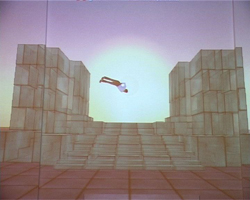 Gekitora’s „wind dance“ on the 3D „Rhythmic Spaces“ set in SL
Gekitora’s „wind dance“ on the 3D „Rhythmic Spaces“ set in SL
working away on the laptops all afternoon, Michael Takeo Magruder prepared the public installation of his „Rhythmic Spaces“ project, to be unveiled in a performance („Meeting Places„) on Sunday, but he had also been previously corresponding with colleagues in Tokyo (conversations between Magruder, myself, and the Tokyo team of the ADAPT network – Association of Dance and Performance Telematics had started a week or two ago) and was willing to invite some visitors into his set. i had suggested to Yukihiko Yoshida and his team mates that it could be exciting to see them appear – and perform spontaneously – within the formally prepared stage setting (3D modeling) of Appia’s „Rhythmic Spaces“ within Second Life which Magruder had worked on for a considerable time. during the evening, Magruder then also invited Ghislaine Boddington, who was visiting the festival and has had prior experience with SL, into the particular space in Second Life to continue chats and preparations.
somehow i imagined it would be a fascinating counterpoint to have the live Hong Kong intervention performance by two artists from Slovenia followed by the performance avat-aria created by Japanese artists within the German 3D model of Appia’s eurythmic Hellerau utopianism, computationally and artistically conceived by a Japanese artist and programmer working in London — in a sense, this is not a WeltbĂĽrgertum as much as it reflects the tremendous cross-over transculturalism and trans-discipline creatvity we see in the contemporary digital arts and sciences.
I will discuss the „Rhythmic Spaces“ project and Meeting Places tomorrow, but end here with a lyrical echo of the late wind dance in Second Life.
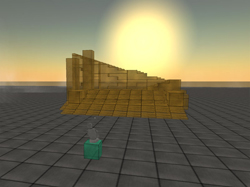 Magruder’s „Rhythmic Spaces /Orpheus“
Magruder’s „Rhythmic Spaces /Orpheus“
Magruder had opened up his SIM territory in SL for a group of visitors (from the UK) and a group of performers (from Japan). Boddington then worked with Magruder and Yoshida (the Tokyo team also include Mr Kabata and Yukito Obara) on establishing the communications Saturday night and adapting the Japanese dancers to the 3D Appia environment and its orphic ambience, including the enormous sun emanating its glow at the horizon line. at around 22:40, just after Stromajer and Zorman had quietly vanished from the Hong Kong skyscraper, Yukito Obara (SL-name: Gekitora Gackt) appeared in the form of his avatar to enact his orphic-Icarus, whirling himself close to the sun and into the winds of the artificial world of Second Life.

the room where i watched this event (the SeitenbĂĽhne Ost) was completely silent. the „wind dance solo“ happened in the quiet deadly eye of the storm of color. life on the re-imagined 3D digital planet Appia, the set of „Rhythmic Spaces“ – an apparation turning into a 20-minute tumbling flight, quietly repetitive but seering the mind, in its utter simplistic foreign machinimatic beauty, its utter uselessness, its extreme aesthetic purposefulness, its controlled spirited quality and anime-quality. this could not have been imagined in 1912 when Adolphe Appia did his sketches of the sun, and the light of spaces and cascading staircases, and when Dalcroze rehearsed with the dancers for the staging of Gluck’s Orpheus and Euydike. but we now watch such avatar presence and performance almost as if logical, as if consequential, even though it is not. anti-gravity, and the fantastical potentialities of the metaverse, are mesmerizing concepts for dreams of flying in space or floating your viewpoint (POV). they do captivate our imagination, just as the old myths of Orpheus and Icarus did.
watch video of „Rhythmic Spaces“
johannes birringer
Tags: 2007, CYNETart, cynetart2007, encounterBLOG, review

